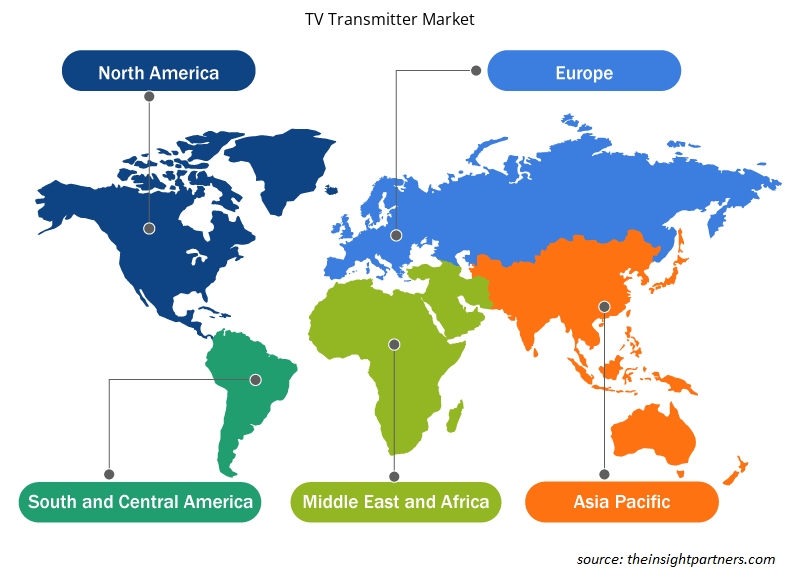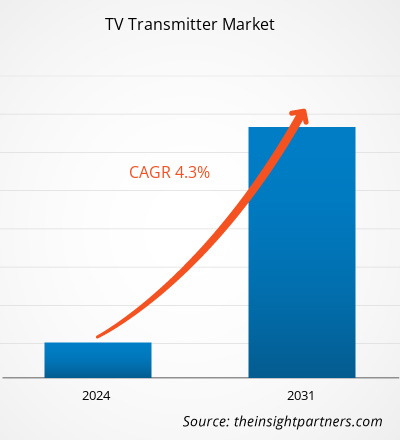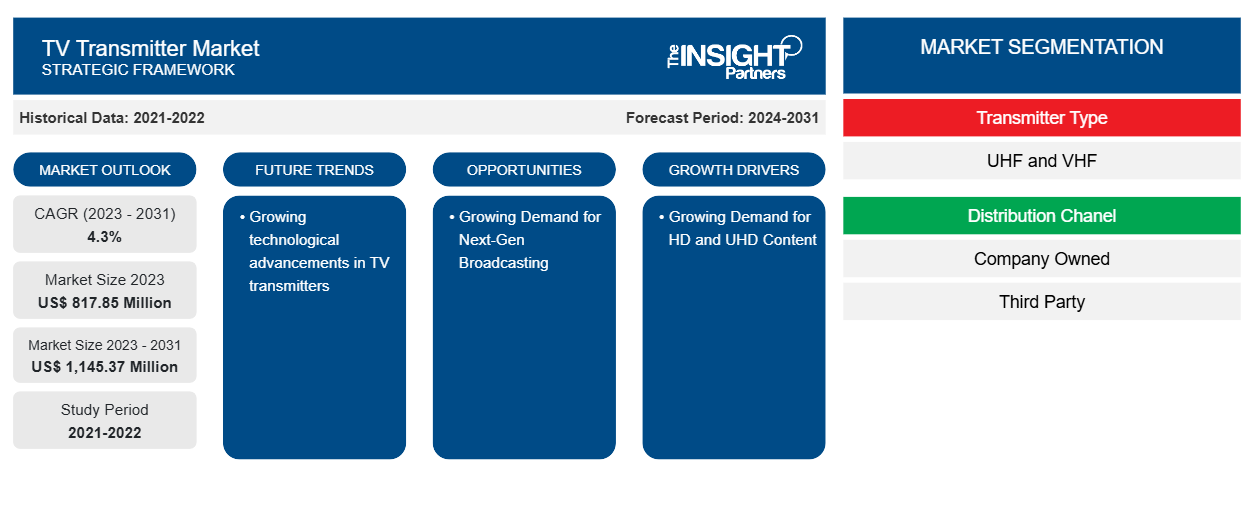Se proyecta que el tamaño del mercado de transmisores de TV alcance los 1.145,37 millones de dólares estadounidenses en 2031, frente a los 817,85 millones de dólares estadounidenses en 2023. Se espera que el mercado registre una CAGR del 4,3 % entre 2023 y 2031. Es probable que la creciente demanda de contenido de alta definición siga siendo una tendencia clave en el mercado de transmisores de TV.
Análisis del mercado de transmisores de TV
La creciente demanda de contenido HD y UHD en todo el mundo es uno de los principales factores que impulsan el crecimiento del mercado de transmisores de TV. Además, las constantes innovaciones en el sector de las telecomunicaciones y la radiodifusión están impulsando el crecimiento del mercado de transmisores de TV. Además, se espera que la creciente demanda de radiodifusión de próxima generación impulse el crecimiento del mercado en el período previsto . Además, los crecientes avances tecnológicos en los transmisores de TV están creando una oportunidad para el crecimiento del mercado de transmisores de TV en los próximos años.
Descripción general del mercado de transmisores de TV
Un transmisor de televisión es un dispositivo eléctrico que emite ondas de radio que transportan tanto la señal de vídeo que muestra una imagen dinámica como la señal de audio que está sincronizada con ella. Será recibida por un receptor de televisión, que mostrará la imagen en la pantalla y reproducirá el sonido correspondiente. Su frecuencia de funcionamiento está limitada a las bandas de frecuencia VHF y UHF y su potencia de salida varía de 5 W a 10 kW. Se emplea habitualmente en el campo de la transmisión televisiva , como en las emisoras de televisión.
Personalice este informe según sus necesidades
Obtendrá personalización en cualquier informe, sin cargo, incluidas partes de este informe o análisis a nivel de país, paquete de datos de Excel, así como también grandes ofertas y descuentos para empresas emergentes y universidades.
-
Obtenga las principales tendencias clave del mercado de este informe.Esta muestra GRATUITA incluirá análisis de datos, desde tendencias del mercado hasta estimaciones y pronósticos.
Factores impulsores y oportunidades del mercado de transmisores de televisión
Demanda creciente de contenido HD y UHD
La demanda de contenido de alta definición ( HD ) y ultraalta definición ( UHD ) está aumentando entre los consumidores de todo el mundo, en particular porque ofrece audio y video de mayor calidad. Además, el uso de plataformas OTT está aumentando en todo el mundo junto con los lanzamientos de contenido de alta calidad. Por lo tanto, la creciente demanda de contenido de alta calidad está impulsando el crecimiento del mercado de transmisores de TV.
CrecienteDemanda de transmisión de próxima generación
La transmisión de próxima generación incluye la adopción de estándares de transmisión digital, y diferentes regiones del mundo han adoptado estándares específicos como ATSC 3.0 en los Estados Unidos, DVB-T2 en Europa e ISDB-Tb en ciertas secciones de Asia y Sudamérica. Los beneficios de estos estándares incluyen una mejor calidad de audio y video, un uso más efectivo del espectro disponible y la incorporación de nuevas funciones interactivas. La transición a los estándares de transmisión digital facilita la transmisión de programación de alta definición ( HD ) y ultraalta definición ( UHD ), lo que brinda a los espectadores una experiencia visual y de audio mucho mejor y aumenta su disfrute de la televisión. Por lo tanto, se espera que la creciente demanda de transmisión de próxima generación cree una oportunidad para el crecimiento del mercado de transmisores de TV.
Informe de mercado de transmisores de TV Análisis de segmentación
Los segmentos clave que contribuyeron a la derivación del análisis del mercado de transmisores de TV son el tipo de transmisor, el canal de distribución y la aplicación.
- Según el tipo de transmisor, el mercado de transmisores de TV se divide en UHF y VHF. El segmento UHF tuvo una mayor participación de mercado en 2023. El segmento UHF se divide a su vez en bajo, medio y alto. De manera similar, el segmento VHF se divide a su vez en bajo y medio.
- Por canal de distribución, el mercado se segmenta en empresas propias y de terceros. El segmento de empresas propias tuvo la mayor participación del mercado en 2023.
- Por aplicación, el mercado se segmenta en pequeñas y grandes cadenas de televisión. El segmento de grandes cadenas de televisión tuvo la mayor participación del mercado en 2023.
Análisis de la cuota de mercado de los transmisores de televisión por geografía
El alcance geográfico del informe del mercado de transmisores de TV se divide principalmente en cinco regiones: América del Norte, Asia Pacífico, Europa, Medio Oriente y África, y América del Sur/América del Sur y Central.
En términos de ingresos, Asia Pacífico representó la mayor participación en el mercado de transmisores de televisión. El mercado en esta región está segmentado en Australia, China, India, Corea del Sur, Japón y el resto de APAC. Los actores del mercado en la región están trabajando continuamente en avances tecnológicos en el sector de la radiodifusión, que es el principal factor que impulsa el crecimiento del mercado de transmisores de televisión en APAC. Además, la región está presenciando un tremendo crecimiento en su industria de medios y entretenimiento, que está impulsando aún más el crecimiento del mercado de transmisores de televisión.
Perspectivas regionales del mercado de transmisores de TV
Los analistas de Insight Partners explicaron en detalle las tendencias y los factores regionales que influyen en el mercado de transmisores de televisión durante el período de pronóstico. Esta sección también analiza los segmentos y la geografía del mercado de transmisores de televisión en América del Norte, Europa, Asia Pacífico, Oriente Medio y África, y América del Sur y Central.

- Obtenga los datos regionales específicos para el mercado de transmisores de TV
Alcance del informe de mercado de transmisores de TV
| Atributo del informe | Detalles |
|---|---|
| Tamaño del mercado en 2023 | US$ 817,85 millones |
| Tamaño del mercado en 2031 | US$ 1.145,37 millones |
| CAGR global (2023 - 2031) | 4,3% |
| Datos históricos | 2021-2022 |
| Período de pronóstico | 2024-2031 |
| Segmentos cubiertos |
Por tipo de transmisor
|
| Regiones y países cubiertos |
América del norteAmerica
|
| Líderes del mercado y perfiles de empresas clave |
|
Densidad de actores del mercado de transmisores de televisión: comprensión de su impacto en la dinámica empresarial
El mercado de transmisores de televisión está creciendo rápidamente, impulsado por la creciente demanda de los usuarios finales debido a factores como la evolución de las preferencias de los consumidores, los avances tecnológicos y una mayor conciencia de los beneficios del producto. A medida que aumenta la demanda, las empresas amplían sus ofertas, innovan para satisfacer las necesidades de los consumidores y aprovechan las tendencias emergentes, lo que impulsa aún más el crecimiento del mercado.
La densidad de actores del mercado se refiere a la distribución de las empresas o firmas que operan dentro de un mercado o industria en particular. Indica cuántos competidores (actores del mercado) están presentes en un espacio de mercado determinado en relación con su tamaño o valor total de mercado.
Las principales empresas que operan en el mercado de transmisores de TV son:
- Rohde y Schwarz
- Corporación NEC
- Grupo eléctrico Hitachi Kokusai
- BTESA
- Egatel
- Puertas de aire
Descargo de responsabilidad : Las empresas enumeradas anteriormente no están clasificadas en ningún orden particular.

- Obtenga una descripción general de los principales actores clave del mercado de transmisores de televisión
Noticias y desarrollos recientes del mercado de transmisores de TV
El mercado de transmisores de televisión se evalúa mediante la recopilación de datos cualitativos y cuantitativos posteriores a la investigación primaria y secundaria, que incluye publicaciones corporativas importantes, datos de asociaciones y bases de datos. A continuación, se incluye una lista de los avances en el mercado de trastornos del habla y el lenguaje y las estrategias:
- ENENSYS Technologies, proveedor líder de soluciones de distribución de medios, y ELECTROLINK, fabricante italiano de transmisores de televisión, anunciaron que han entregado con éxito a Rai Way todos los sistemas transmisores DVB-T/T2 que operan en las regiones de Abruzzo, Lazio y Liguria, relacionados con el proyecto de reorganización en Italia, que se encargó mediante una licitación pública. ENENSYS y ELECTROLINK han creado una asociación especial para este proyecto, en la que cada empresa proporciona los mejores componentes y servicios de ingeniería para entregar el sistema transmisor DVB-T/T2 más eficiente, confiable y de última generación a Rai Way. (Fuente: ENENSYS Technologies, Nota de prensa, 2023)
- Hope Channel Central Philippines inauguró el nuevo estudio y transmisor en la sede de la Unión Conferencia Central de Filipinas (CPUC) en la ciudad de Cebú, Filipinas. (Fuente: Adventistas, comunicado de prensa, 2023)
Informe de mercado de transmisores de televisión: cobertura y resultados
El informe “Tamaño y pronóstico del mercado de transmisores de TV (2021-2031)” proporciona un análisis detallado del mercado que cubre las siguientes áreas:
- Tamaño del mercado y pronóstico a nivel global, regional y nacional para todos los segmentos clave del mercado cubiertos bajo el alcance
- Dinámica del mercado, como impulsores, restricciones y oportunidades clave
- Principales tendencias futuras
- Análisis detallado de las cinco fuerzas de Porter y PEST y FODA
- Análisis del mercado global y regional que cubre las tendencias clave del mercado, los principales actores, las regulaciones y los desarrollos recientes del mercado.
- Análisis del panorama de la industria y de la competencia que abarca la concentración del mercado, el análisis de mapas de calor, los actores destacados y los desarrollos recientes
- Perfiles detallados de empresas
- Análisis histórico (2 años), año base, pronóstico (7 años) con CAGR
- Análisis PEST y FODA
- Tamaño del mercado, valor/volumen: global, regional y nacional
- Industria y panorama competitivo
- Conjunto de datos de Excel
Informes recientes
Informes relacionados
Testimonios
Razón para comprar
- Toma de decisiones informada
- Comprensión de la dinámica del mercado
- Análisis competitivo
- Información sobre clientes
- Pronósticos del mercado
- Mitigación de riesgos
- Planificación estratégica
- Justificación de la inversión
- Identificación de mercados emergentes
- Mejora de las estrategias de marketing
- Impulso de la eficiencia operativa
- Alineación con las tendencias regulatorias























 Obtenga una muestra gratuita para - Mercado de transmisores de TV
Obtenga una muestra gratuita para - Mercado de transmisores de TV